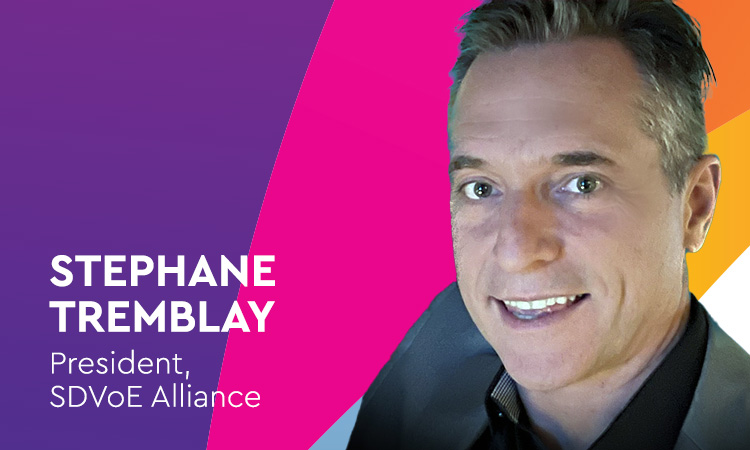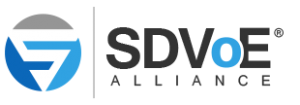
Beyond Traditional Switching and How SDVoE’s Zero Latency Rivals Matrix Switch Performance
Stephane Tremblay
President, SDVoE Alliance
Across industries, no two audiovisual systems are alike. A healthcare facility requires different workflows and security protocols than a university lecture hall. A live event venue needs real-time switching and seamless multiview feeds, while a corporate training environment demands reliability and scalability. Yet for too long, integrators and developers have been forced to fit unique needs into one-size-fits-all platforms that limit creativity and flexibility.
Today’s audiovisual users expect systems designed for their specific industry demands that can be adapted, updated and extended as needs evolve. The SDVoE Alliance’s Standard Software Interface was built to meet the growing demands of industry professionals. By giving developers unprecedented access to the underlying power of SDVoE technology, the Standard Software Interface enables tailored solutions for virtually any application, empowering a new era of customized AV.
Every market sector places unique demands on audiovisual technology:
- Healthcare: Telemedicine suites, diagnostic imaging centers and hospital command hubs require secure, low-latency video with strict compliance to privacy and data regulations.
- Education: Lecture capture, interactive classrooms and campus-wide broadcasting call for seamless integration with learning management systems and multi-room scalability.
- Live Events: Concerts, theaters and sports venues rely on dynamic switching, multiview displays and robust remote control to handle rapid changeovers and real-time visuals.
- Command Centers: Public safety, military and corporate operations rooms need mission-critical reliability, instant switching and advanced video wall management to process complex data streams.
Traditional audiovisual platforms often fall short across the unique needs of healthcare, education, live events and command centers, requiring costly custom hardware or external processors to achieve even basic customization. SDVoE’s Standard Software Interface removes these barriers by delivering a powerful, flexible foundation designed for the modern, software-driven audiovisual era.
The SDVoE Standard Software Interface provides manufacturers, developers and system integrators with direct access to core audiovisual functions, from switching and routing to scaling and compositing. The unprecedented access enables teams to reimagine traditional audiovisual use cases and create entirely new ones that were not previously conceived or possible with legacy systems. For example, an integrator could build a custom control interface for a hospital’s surgical visualization system or design a student-centered classroom experience that combines live video, interactive content and remote guest lectures — all using the same SDVoE backbone.
Since SDVoE’s Standard Software Interface integrates seamlessly with cloud services, developers can also extend their applications beyond the physical site. Remote management, monitoring and control become not just possible but intuitive, reducing downtime and enabling more proactive support.
SDVoE’s Standard Software Interface supports sophisticated programming tasks such as video walls, instant switching and multiview, which are traditionally areas that have demanded expensive dedicated hardware and manual configuration. By handling these functions in software, developers and integrators can deliver advanced capabilities without incurring extra costs, downtime or complexity.
The SDVoE Alliance’s software-driven approach accelerates deployment and facilitates the rollout of updates or new features. A feature that might once have required new hardware can now be delivered as a software upgrade, extending the lifecycle of installed systems and reducing environmental impact.
Customization shouldn’t come at the expense of security. SDVoE incorporates stream encryption, secure control communications and device authentication to protect AV content and control data. The SDVoE Alliance’s non-intrusive, secure connection eliminates the need for vulnerable PC- or Windows-based processors, reducing cyberattack risks and tampering threats, which is a critical consideration for healthcare, command centers and other sensitive deployments.
For developers, the SDVoE Standard Software Interface is a creative toolkit, opening up possibilities once limited to specialized hardware or proprietary platforms. For integrators, it’s a path to differentiation, enabling them to deliver bespoke solutions that stand out in competitive markets. For end users, it’s an assurance that their audiovisual systems can evolve alongside their industry, business model and technology roadmap.
By making audiovisual systems programmable and adaptable, SDVoE’s Standard Software Interface shifts audiovisual from a static, hardware-bound model to a dynamic, software-defined infrastructure aligned with modern IT best practices. With SDVoE’s Standard Software Interface, developers and integrators can craft tailored solutions that address the precise needs of healthcare, education, live events, command centers and beyond. The flexibility of SDVoE technology is designed to empower innovation, safeguard investments, reduce downtime and future-proof audiovisual installations against the rapid pace of change.
For more information on the SDVoE Alliance, please visit www.sdvoe.org. Keep up with the latest news from the SDVoE Alliance on LinkedIn,Twitter and YouTube.

